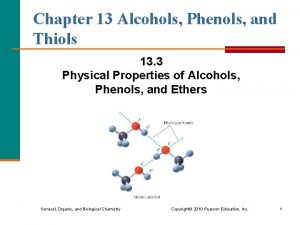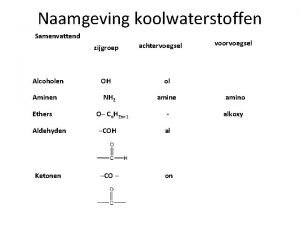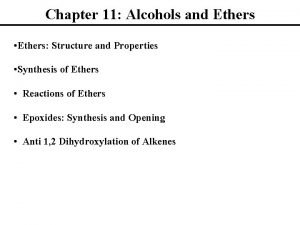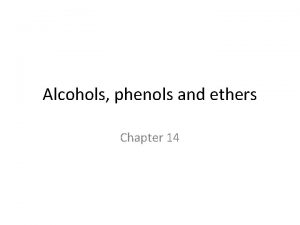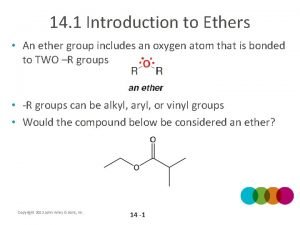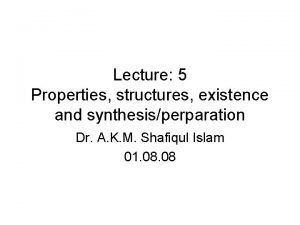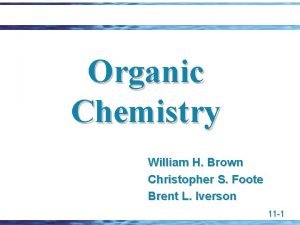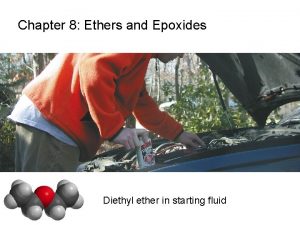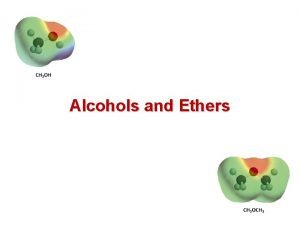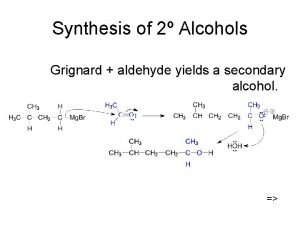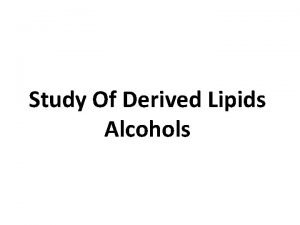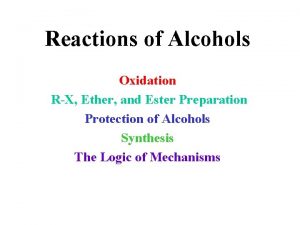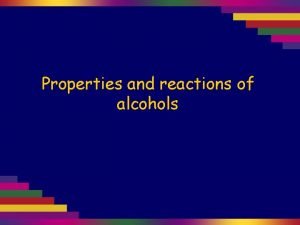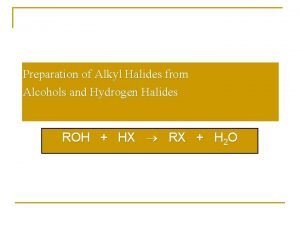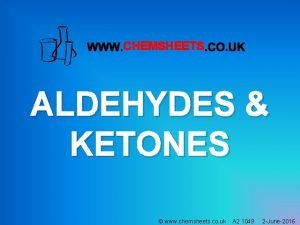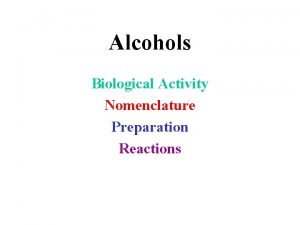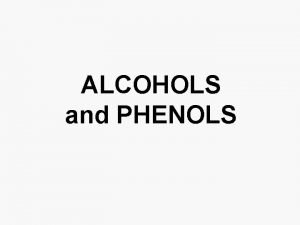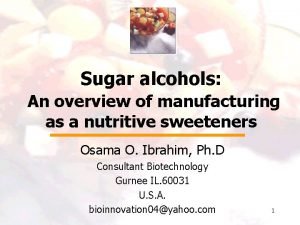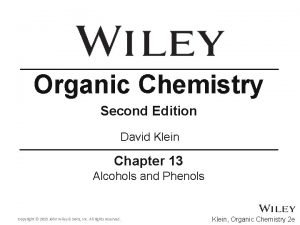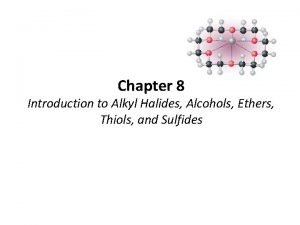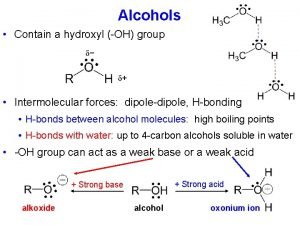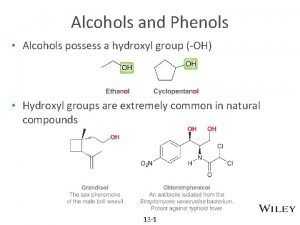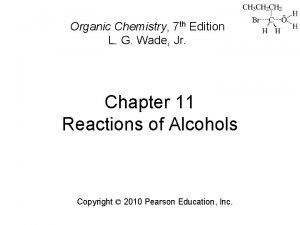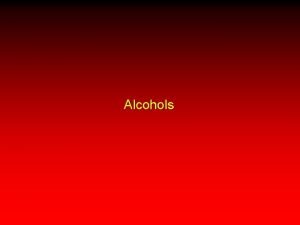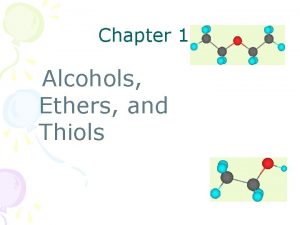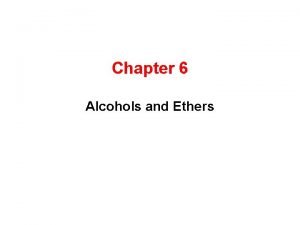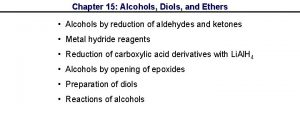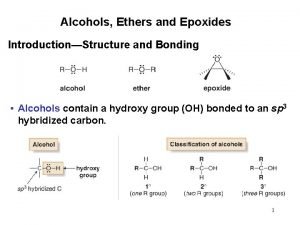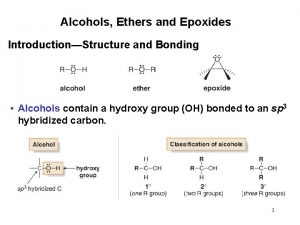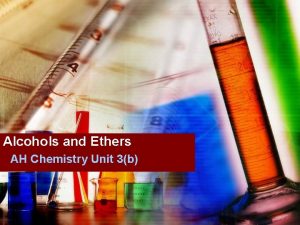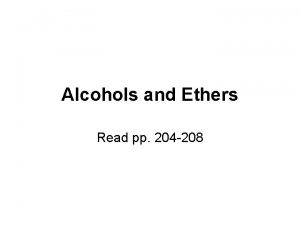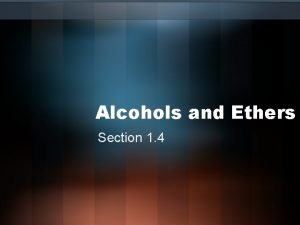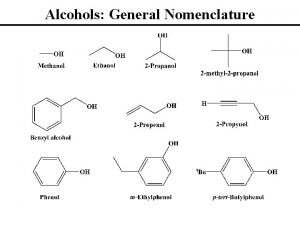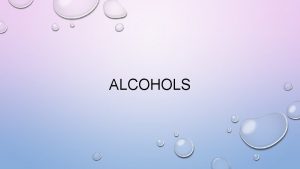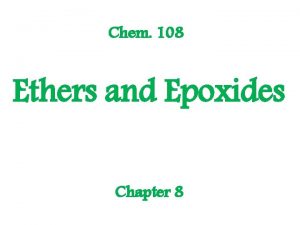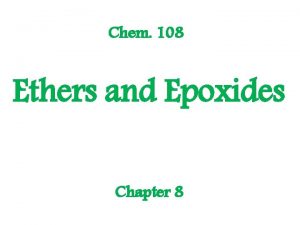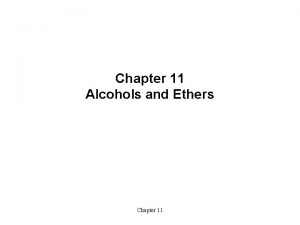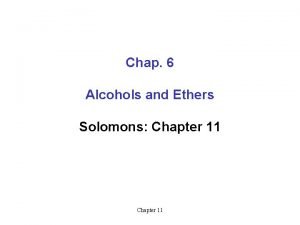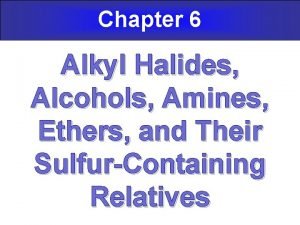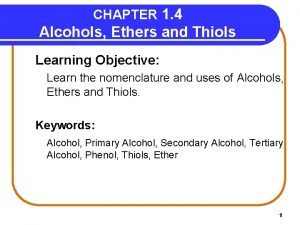Chapter 11 Alcohols and Ethers Alcohols and Ethers



























- Slides: 27

Chapter 11: Alcohols and Ethers • • • • Alcohols and Ethers: Structure and Properties (Sections 11. 1 -2) Important Alcohols and Ethers (Section 11. 3) Synthesis of Alcohols from Alkenes (Section 11. 4; Chapter 8) Reactions of Alcohols (Section 11. 5) Old Acid Base Stuff (Section 11. 6, Chapter 3) Alcohols into Alkyl Halides (Section 11. 7) Alcohol Reactions w/ HX (Section 11. 8) Alcohol Reactions w/ PBr 3, SOCl 2 (Section 11. 9) Alcohol Derivatives as Leaving Groups (Section 11. 10) Synthesis of Ethers (Section 11. 11) Reactions of Ethers (Section 11. 12) Epoxides: Synthesis and Opening (Sections 11. 13 and 11. 14) Anti 1, 2 Dihydroxylation of Alkenes (Section 11. 15)

Alcohols: General Nomenclature

Substitution in Benzene Rings Use para/meta/ortho Designations to Describe Substituent Orientation in Disubstituted Benzene Rings, Just as in the Phenol Examples from Previous Slide

Alcohols and Ethers: Physical Properties • Properties of Ethers Similar to Alkanes of Like Masses Ø Diethyl ether (MW=74); Pentane (MW=72) Ø Diethyl ether (BP=34. 6 °C); Pentane (BP=36 °C) • Alcohols Boil Much Higher than Comparable Ethers/Alkanes • Related to Hydrogen Bonding of Alcohols (See Chapter 4) • Alcohols form Hydrogen Bonding Networks w/ one Another • Ethers Cannot Hydrogen Bond w/ one Another • Ethers CAN H-Bond w/ H 2 O and Alcohols (Soluble in These) Properties of Some Alcohols/Ethers in Tables 11. 1 and 11. 2

Important Alcohols and Ethers • Methanol (CH 3 OH) • Often Called Wood Alcohol (Distilled From Wood) • Prepared Now via Catalytic Hydrogenation Reactions • Ethanol (CH 3 CH 2 OH) • Made Through Fermentation of Sugars, in Alcoholic Drinks • Common Solvent in Organic Labs (Absolute Ethanol) • Ethylene Glycol (HOCH 2 OH) • Good Antifreeze: Low MW, High Boiling Point (197 °C) • Diethyl Ether (CH 3 CH 2 OCH 2 CH 3) • Low Boiling Point, Volatile, Highly Flammable Liquid • One of First Uses was as Surgical Anesthetic • Watch Out for Old Ether Containers (Peroxides!!)

Synthesizing Alcohols from Alkenes • We’ve Looked at Several OH Synthesis Reactions in Ch. 8 Ø Acid-Catalyzed Hydration (Markovnikov) Ø H 3 O+/H 2 O OR warm, dilute H 2 SO 4, H 2 O Ø Oxymercuration/Demercuration (Markovnikov) Ø 1. Hg(OAc)2 THF/H 2 O 2. Na. BH 4, Na. OH Ø Hydroboration/Oxidation (Anti-Markovnikov) Ø 1. BH 3 : THF 2. H 2 O 2, Na. OH • Now Let’s Consider Some Reactions of Alcohols

Reactions of Alcohols • Lone Pairs on Alcohols: Lewis Bases, Nucleophiles • Note Bond Polarizations: C, H are d+ and O is d¯ • Alcohol Carbon Not Particularly Electrophilic (HO¯ Bad LG) • Protonation of Alcohol H 2 O; Good Leaving Group

Reactions of Alcohols • Protonation of Alcohol H 2 O; Good Leaving Group • Presence of Good Leaving Group Makes COH Electrophilic • OH 2+ More Electron Withdrawing than OH; More Polarized • Can Observe SN 1 or SN 2 Reactions (Depends on Alcohol Class)

Reactions of Alcohols • Protonation of Alcohol H 2 O; Good Leaving Group • Another Alcohol Moleculae Can React, Get Protonated Ether • Subsequent Deprotonation Ether Product (Symmetric Here) • Reaction is CONDENSATION of Two Alcohols

Converting Alcohols into Alkyl Halides

HX Reactions with Alcohols (3°, 2°)

HX Reactions with Alcohols (1°, Me. OH) • As Seen Previously, Protonation Makes Good Leaving Group • Presence of Nucleophile (Br) Allows for Substitution Reaction • Can also Add Lewis Acid to Help (esp. Zn. Cl 2 w/ Cl¯)

Alcohol Reactions w/ PBr 3, SOCl 2 • P and S Atoms are Electrophilic Sites, O acts as Nucleophile • Low Temperatures w/ PBr 3 Prevent C Skeleton Rearrangement • PBr 3 Reaction Choice Reagent for 1°, 2° OH 1°, 2° Br • SOCl 2 Good Reagent for 1°, 2° OH 1°, 2° Cl • Reaction Usually Run with Added Amine Base (Consume HCl) • SOCl 2 Reactions Also Typically Don’t Involve Rearrangements • Will Later See SOCl 2 Replaces OH of Carboxylic Acid with Cl

Leaving Groups: OH Derivatives • Make OH Better as Leaving Group (Replace H, Bond to O) • This General Class is Called the Sulfonate Ester Class • Prepared By Reacting Alcohol w/ a Sulfonyl Chloride and Base • Formation of Derivatives does not Alter C—O Stereochemistry

Leaving Groups: OH Derivatives Sample Derivatizations. Note Retention of Stereochemistry in 2 nd

Synthesis of Ethers We’ve Already Seen Ether Synthesis by Alcohol Dehydration: • Utility of this Reaction is Limited in its Scope: Ø Mixture of Ether/Alkenes with 2° Alkyl Groups Ø Exclusively Alkenes with 3° Alkyl Groups Ø Only Useful for Synthesis of Symmetric Ethers Ø ROH + R’OH ROR + R’OR’

Williamson Synthesis of Ethers Unsymmetrical Ethers From RONa + Halide, Sulfonate, etc. • Utility of this Reaction is Much Greater Than Condensation: Ø Works with 1° and 2° Halides, Sulfonates, etc. Ø Still Exclusively Alkenes with 3° Alkyl Groups Ø Lower Temperatures Favor Substitution over Elimination Ø SN 2 Conditions Apply Prefer Unhindered Substrate

Alkoxymercuration-Demercuration This Reaction is Analogous to Oxymercuration-Demercuration • Using New Hg Salt Here (Triflate) Can Use Hg(OAc)2 Also • Instead of H 2 O in First Step, We Use an Alcohol • Carbocation is Captured by Alcohol Molecule • After Loss of Proton, Alkoxide is Added Instead of Alcohol • See Chapter 8 for Mechanistic Details (Completely Parallel)

Protecting Groups: Alcohol Alkylation • Alcohol Groups do not “Survive” Many Organic Reactions • Alkylation (Ether Formation) Protects OH’s During Synthesis • Can Remove the Protecting Group w/ Dilute Aqueous Acid • Generally Dissolve Alcohol in Acid, THEN add Isobutylene • Addition in this Manner Minimizes Isobutylene Dimerization • Let’s See Why We Might Want to Use a Protecting Group

Protecting Groups: How They Work

Protecting Groups: Silyl Ethers • Silyl Ethers Stable Over a 4 -12 p. H Range (Acidic and Basic) • Can Survive Conditions of Many Organic Reactions • Typically Removed w/ Flouride Source (NBu 4 F; aka TBAF) • Silyl Ethers More Volatile Than Alcohols (GC Applications)

Ether Reactions w/ Strong Acids • Ethers Can be Protonated by Strong Acids (Oxonium Ions) • w/ 2 Equivalents of Acid (HX), Cleaved to 2 Eq. Alkyl Halide Ø Protonation, SN 2, Protonation, SN 2

Ether Cleavage by HBr: Mechanism • Two Equivalents of Ethyl bromide Produced (+ H 2 O)

Synthesis of Epoxides • Three-Membered Oxygen Containing Ring; Use Peroxy Acid

Some Peroxyacids • Reactive, Often Unstable Species: Chemists use More Stable

Epoxide Opening: Acid-Catalyzed • Epoxides Are Reactive to Opening Due to Ring Strain • After Protonation, Opening is SN 2 Like Reaction (Anti) • “Desire” to Relieve Ring Strain Good Electrophiles

Epoxide Opening: Base-Catalyzed • Epoxides Are Ethers That Can be Attacked by Bases • Reactivity is Due to Ring Strain (Increases Electrophilicity) • As in Acid Case, Opening is an SN 2 Reaction • Can Open With Strong Base, Hydroxide and Alkoxide Usual
 Alcohols phenols thiols and ethers
Alcohols phenols thiols and ethers Ethers naamgeving
Ethers naamgeving Esters naming
Esters naming Ether naming
Ether naming Ethers naming
Ethers naming Ether naming
Ether naming Ethers boiling point
Ethers boiling point David klein organic chemistry
David klein organic chemistry Cis-2 3-dimethyloxirane
Cis-2 3-dimethyloxirane Why are ethers relatively inert compounds
Why are ethers relatively inert compounds Acidic cleavage of ethers
Acidic cleavage of ethers Oxidation of tertiary alcohol
Oxidation of tertiary alcohol Tertiary alcohol synthesis
Tertiary alcohol synthesis These are alcohols containing cppp nucleus
These are alcohols containing cppp nucleus Secondary alcohols
Secondary alcohols Lucas test mechanism
Lucas test mechanism Chlorination
Chlorination Hydrogen halide
Hydrogen halide Chemsheets reactions of alcohols 1 answers
Chemsheets reactions of alcohols 1 answers What does na2cr2o7 do
What does na2cr2o7 do Sp
Sp Names of sugar alcohols
Names of sugar alcohols Alcohols nomenclature
Alcohols nomenclature Naming alkyl halides
Naming alkyl halides Ethyl propyl ether structure
Ethyl propyl ether structure What does pcc ch2cl2 do
What does pcc ch2cl2 do Lucas test
Lucas test 7 ionic and metallic bonding
7 ionic and metallic bonding
